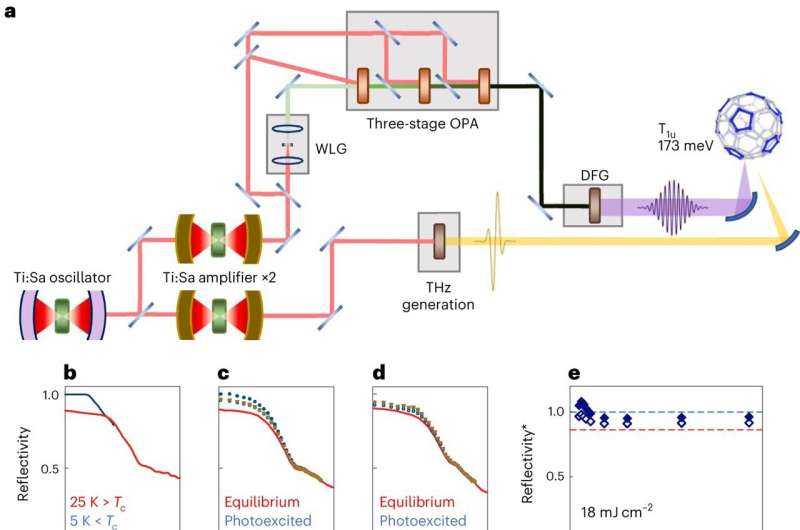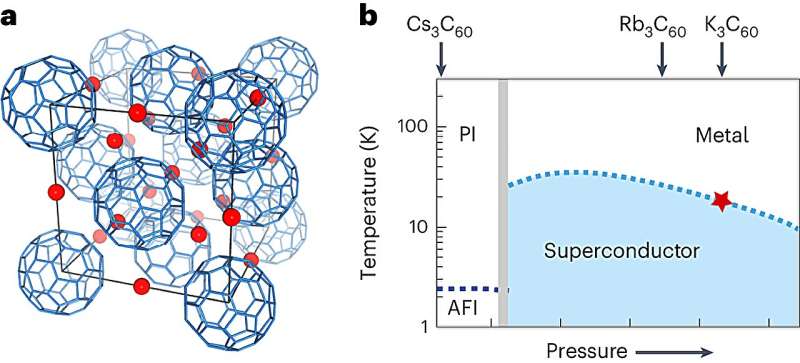October 15, 2023 feature
This article has been reviewed according to Science X's editorial process and policies. Editors have highlighted the following attributes while ensuring the content's credibility:
fact-checked
peer-reviewed publication
trusted source
proofread
A strategy to enhance the light-driven superconductivity of K₃C₆₀

Superconductivity is the ability of some materials to conduct a direct electrical current (DC) with almost no resistance. This property is highly sought after and favorable for various technological applications, as it could boost the performance of different electronic and energy devices.
In recent years, condensed-matter physicists and material scientists have been trying to identify strategies to enhance the superconductivity of specific materials. This includes the material K3C60, an organic superconductor that has been found to enter a phase characterized by zero resistance when mid-infrared optical pulses are applied to it.
Researchers at the Max Planck Institute for the Structure and Dynamics of Matter, Università degli Studi di Parma and University of Oxford have now identified a strategy to enhance the light-induced superconductivity of K3C60. This strategy, outlined in Nature Physics, has so far yielded very promising results, increasing the photo-susceptibility of this superconducting material by two orders of magnitude.
"We have been exploring for approximately a decade the possibility of using light to enhance superconductivity starting form an equilibrium state at base temperature above Tc," Andrea Cavalleri, one of the researchers who carried out the study, told Phys.org. "We have shown that this works in some cuprates, in certain charge transfer salts and in K3C60."
"In this paper, we have explored the mechanism underlying the K3C60 optically induced superconductivity using a special optical source that is much more tunable than that used previously, reaching 10 THz frequency."

Cavalleri and his research team have been exploring the superconductivity of K3C60 for a few years now. In their previous experiments, they were able to realize the superconducting phase of this material with excitation photon energies ranging between 80 and 165 meV (20–40THz).
In their new study, they set out to explore excitation in the material at lower energies between 24 and 80 meV (6–20 THz), using a strategy that was previously inaccessible to them. The researchers achieved this using a terahertz source that generates narrow-bandwidth pulses by combining the near-infrared signal beams of two distinct phase-locked optical parametric amplitudes.
"The underlying physics is not yet clear, but the experiment targets selected molecular vibrations that are driven directly to large amplifies at their resonance frequency," Cavalleri said. "The driven vibrations appear to couple with the electronic states and enhance the pairing and coherence that give rise to superconductivity. The present paper shows that this effect works especially well at 10 THz, where a certain molecular vibration is found."
The recent work by Cavalleri and his collaborators sheds some new light on the possible mechanisms underpinning photo-induced superconductivity in K3C60 and potentially other superconductors. In addition, it introduces a strategy that could help to prolong photo-induced superconductivity for longer periods of time, which could have interesting implications for the development of light-driven quantum technologies.
"We realized a 10 ns long lived superconducting state at room temperature," Cavalleri added. "In principle, this could be used for future quantum devices powered by light. We want to study the properties of this transient state, especially magnetic properties and we are going to try to compare the properties of the photo-induced phase to those of equilibrium SC."
More information: E. Rowe et al, Resonant enhancement of photo-induced superconductivity in K3C60, Nature Physics (2023). DOI: 10.1038/s41567-023-02235-9.
Journal information: Nature Physics
© 2023 Science X Network





















